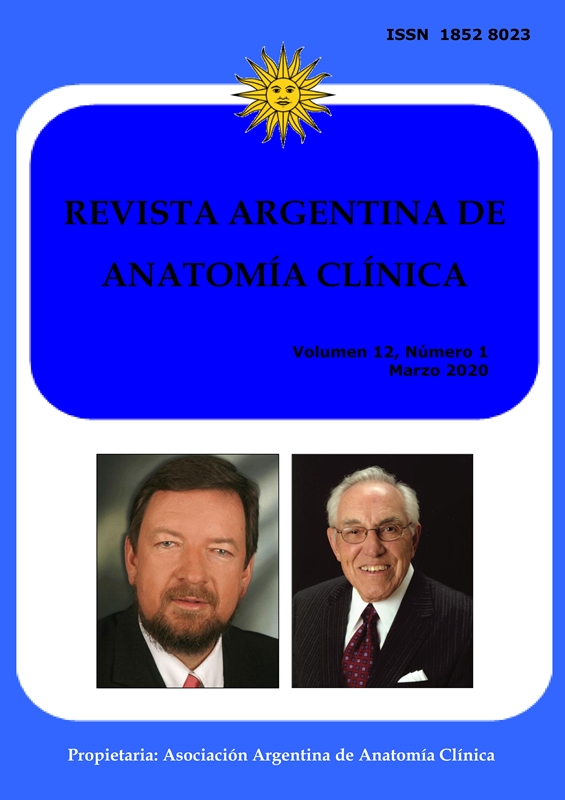Origin of the porta vein: anatomy study
DOI:
https://doi.org/10.31051/1852.8023.v12.n1.27560Keywords:
Veins, Variations, AfluentsAbstract
Introduction: classically the portal vein originates from the confluence of the superior mesenteric vein and splenic mesenteric trunk, last one conformed by the splenic and inferior mesenteric veins. Its conformation and main tributaries does not escape from presenting anatomical variations, which the surgeon must know and anticipate, at the time of approaching the pancreatic duodenum massif in order to avoid catastrophic consequences. The objective is the study of the conformation, dimensions and spatial arrangement of the origin of the portal vein, and its main tributaries. Materials and method: 50 cadavers were. Portal vein origin, caliber and its tributaries were recorded. Flaring angles and vertebral projection level. Results: three types of origin were distinguished. Type I was recorded in 78% of cases, type II in 18% and type III in 4%. The calibers were: portal vein 16.12 mm, superior mesenteric 11.77 mm, splenic 9.34 mm, inferior mesenteric 5.03 mm and splenomesaraic trunk 10.44 mm. The latter reached a length of 20.26 mm. The angles were: portal angle - splenomesenteric trunk 124.18 °, upper mesenteric angle - splenomesenteric trunk 101.92 ° and lower mesenteric angle - splenic 75.4 °. In 75% of cases the level of vertebral projection was the upper third of L2. Conclusions: the most frequent origin was according to the classically described. About variants, the meeting of the superior mesenteric vein with the splenic vein is more constant, being the termination of inferior mesenteric vein more variable.
References
Al-Awad A, Granados A, Sánchez A, Sánchez M, Fernández R. 2012. Variante anatómica del origen de la vena porta: a propósito de un caso. Rev Arg Anat Onl 3(4):116–9.
Bacallao I, Tamayo E, Pérez L. 2005. Variantes anatómicas en la irrigación hepática y Vías Biliares. AMC 9(5):36–45.
Bouchet A CJ. 1994. Anatomía Descriptiva, Topográfica y Funcional: Abdomen. 1era Edición. Buenos Aires: Editorial Panamericana, pag 378 – 388.
Castaing D, Veilhan LA. 2006. Anatomie du foie et des voies biliaires. In: Techniques chirurgicales - Appareil digestif. Paris: Elsevier Masson, pag 40–760.
Hu GH, Shen LG, Yang J, Mei JH ZY. 2008. Insight into congenital absence of the portal vein: Is it rare? World J Gastroenterol 14(39):5969–79.
Latarjet A, Ruiz Liard A. 2007. Anatomía humana. 4ta Edición. Buenos Aires: Editorial Panamericana, pag: 1388-1393.
Maksoud R, Dunia A, Antonetti C. 2013. Variaciones anatómicas en la formación del sistema venoso portal y desembocadura del hilio hepático. Rev la Soc Venez Ciencias Morfológicas. 19:33–7.
Marks C. 1969. Developmental basis of the portal venous system. Am J Surg 117(5):671–681.
Pró E. 2012. Anatomía Clinica. 1era Edición. Buenos Aires: Editorial Panamericana, pag 597-598.
Rouviere H, Delmas A. 1964. Anatomia Humana descriptiva y topofgráfica Tomo II Anatomia del Tronco. 7ma Edición. Madrid: Editorial Bailly-Bailliere S.A, pag: 185–92.
Skandalakis JE et al. 2004. Hepatic surgical anatomy. Surg Clin N Am 84:413–435.
Testut L. 1949. Tratado de Anatomía Humana: Tomo IV Aparato Digestivo. 6ta Edición. Barcelona: Salvat, pag: 382–90.
Downloads
Published
Issue
Section
License
Authors retain copyright and grant the journal right of first publication with the work simultaneously licensed under a Creative Commons Attribution License that allows others to share the work with an acknowledgement of the work's authorship and initial publication in this journal. Use restricted to non commercial purposes.
Once the manuscript has been accepted for publications, authors will sign a Copyright Transfer Agreement to let the “Asociación Argentina de Anatomía Clínica” (Argentine Association of Clinical Anatomy) to edit, publish and disseminate the contribution.



